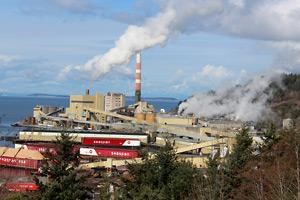Catalyst Paper Corporation’s market environment is demanding so improvements are being made to remain competitive.
Fred Chinn, general manager of Catalyst’s Powell River division, said in terms of productivity and costs, the mill faces challenges. Year-to-date, the amount of time that paper was being produced on the mill’s three machines is as follows: No. 9, 82 per cent, No. 10, 80 per cent and No. 11, 85 per cent.
“Machines of our style should run at 88 to 90 per cent,” Chinn said. “We’ve put in a lot of effort to understand our machines. There’s no technical reason why these machines should run at these percentages. We believe we can do better. One of the key milestones of productivity and profitability is how many tonnes of paper we can make.”
Chinn said the paper industry is faced with a challenging market. He said typically at this time of year, US Thanksgiving and Christmas flyers and publications of that nature are booming, and people are ordering lots of paper.
“They’re not,” he said. “We are seeing a whole other market that we weren’t expecting. This is usually a busy time for pulp and paper mills in North America. We are all feeling it.”
Chinn said the economy does not seem to be the factor. Something is happening out there and it is being watched closely, Chinn said.
“We’re nervous. It’s making us a little bit anxious.”
In terms of staffing in Powell River, Chinn said this year alone, the mill has hired 50 new workers. He said some new positions have been added, but most hires have been to replace an “enormous number of retirements.” In 2013, the mill hired 60 workers.
“We’ve turned over just about a quarter of our population in less than two years,” Chinn said. “We are expecting similar numbers in the year ahead. We are seeing tremendous turnover. The good news is we have new employees, new young families.”
The challenge moving forward is the loss of experience. There are millworkers with 35 or 40 years’ tenure who are now retiring and that experience goes out the door.
The current age demographics show the bulk of employees are between the ages 50 to 59 years old, Chinn said. There are retirements monthly, sometimes almost weekly. During the next five years, three-quarters of the mill staff will turn over.
When people come to Powell River to work in the mill they tend to stay, Chinn said. “They like the mill, they like the area, and we have a lot of long-term employees,” he said. He added that 30 to 40 years of service is common, and there’s an employee with 47 years’ service.
Regarding the mill’s products, Chinn said one of the myths of papermaking is that trees are cut down to make paper. He said trees are harvested to make lumber and the mill uses wood waste from sawmills. It takes 45 trees to make the average house, the mill manager said. Wood that is not used as dimension lumber is chipped and sold to the mill by the sawmills.
The paper mill takes the round-edge waste, and from those 45 trees, can make 10 tonnes of paper. The bark from those 45 trees is put through a power boiler to generate electricity. That bark would generate enough electricity to power the house manufactured from the 45 trees for six months.
Catalyst’s strength, with the seven paper machines in the three mills (Port Alberni, Crofton and Powell River), is the company makes just about every grade of printing paper. Technology, however, has created challenges.
“The electronic age is here,” Chinn said. “We know that. With most grades of paper: catalogue, magazine, directories, and even newspapers, you can see what’s happening.”
The insert and flyer market, the company’s main sales outlet, consumes just about every grade of paper that Catalyst makes.
“We figured this out quite a long time ago,” he said. “A lot of our competitors hadn’t figured it out. That’s the market if you want to sell paper.” Chinn said weekend newspapers that carry the flyers are not getting thinner.
With the requirement for many different grades of paper in the flyer market, Catalyst can move with the demand and provide the type of paper that the printers want.
“Almost 50 per cent of all the paper made at Catalyst goes into retail inserts,” Chinn said. “We went to a market that is stable and strong and we listened to our customers. We focused on this a long time ago and have a foothold in this market. We are in a good position to ride out this storm because we bet on the right horse a long time ago.
“It’s still a challenging market. There is no doubt.”
In terms of other end-markets for Catalyst papers, directory orders amount to 15 per cent of output, newspaper is 13 per cent, catalogue is 11 per cent, magazine is nine per cent, and the book market is three per cent, as is commercial printing.
The majority of Catalyst’s paper, about 90 per cent, is sold in North America.
Chinn said paper is a commodity so it is imperative for Catalyst’s mills to be cost-competitive.
“We have to look at how we can operate our mills in the most cost-effective way,” Chinn said. “The high-cost producers disappear. They are the ones to shut down first.”
The company is now looking into markets that it is not penetrating. Just a half per cent penetration into a market can result in tens of thousands of tonnes of production on the paper machines, Chinn said.
“We are constantly looking at what grades we can develop.”



